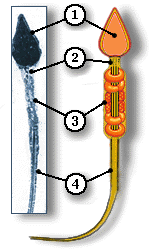 SUPPLEMENTARY: 5
SUPPLEMENTARY: 5 SUPPLEMENTARY: 5
SUPPLEMENTARY: 5
Spermatozoa
The tail is made up of a neck, middle peice a principal piece and an end piece. Running along the entire length of the tail is a microfibrillar structure, the axoneme which is responsible for the swimming activity of the sperm. The axoneme has the same microstructure as a flagellum or cilium with nine outer doublet tubules and a central tubule pair.
The neck (2) contains the pair of centrioles one of which is continuous with the axoneme.
The core of the middle piece (3) is the axoneme enclosed by nine coarse fibres which is then surrounded by tightly packed mitochondria. These mitochondria control the release of energy necessary for the motility of the sperm. The principal part of the tail (4) is composed of the coarse fibres surrounding the axoneme. Distally the coarse fibres are lost and the end piece consists only of the axoneme.
During spermiogenesis, the spermatids are embedded in pockets in the Sertoli cell membrane, and the Sertoli cells phagocytose virtually all of the spermatid cytoplasm apart from the cytoplasmic droplet which is lost during maturation in the epididymis.
When the sperm are released into the lumen of the seminiferous epithelium, they are immotile and infertile and only after 14 days of storage in the epididymis will they be capable of active swimming when exposed to the metabolic substrate fructose in the seminal fluid or be capable of undergoing the final changes during capacitation which result in full fertility.
| Core | Supplementary Material on Spermatogenesis | ||
| Return to Core | Seminiferous tubule (MP) | Spermatogenesis (VHP) | Sertoli cells diagram |
| Sertoli cells (VHP) | Spermatozoa | - | Return to Male Reproductive System Main Index |